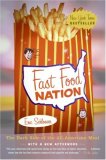Summary | Excerpt | Reading Guide | Reviews | Readalikes | Genres & Themes | Author Bio

Critics' Opinion:
Readers' Opinion:
First Published:
Jan 2001, 288 pages
Paperback:
Jan 2002, 384 pages
A hamburger and french fries became the quintessential American meal in the 1950s, thanks to the promotional efforts of the fast food chains. The typical American now consumes approximately three hamburgers and four orders of french fries every week. But the steady barrage of fast food ads, full of thick juicy burgers and long golden fries, rarely mentions where these foods come from nowadays or what ingredients they contain. The birth of the fast food industry coincided with Eisenhower-era glorifications of technology, with optimistic slogans like "Better Living through Chemistry" and "Our Friend the Atom." The sort of technological wizardry that Walt Disney promoted on television and at Disneyland eventually reached its fulfillment in the kitchens of fast food restaurants. Indeed, the corporate culture of McDonald’s seems inextricably linked to that of the Disney empire, sharing a reverence for sleek machinery, electronics, and automation. The leading fast food chains still embrace a boundless faith in science — and as a result have changed not just what Americans eat, but also how their food is made. The current methods for preparing fast food are less likely to be found in cookbooks than in trade journals such as Food Technologist and Food Engineering. Aside from the salad greens and tomatoes, most fast food is delivered to the restaurant already frozen, canned, dehydrated, or freeze-dried. A fast food kitchen is merely the final stage in a vast and highly complex system of mass production. Foods that may look familiar have in fact been completely reformulated. What we eat has changed more in the last forty years than in the previous forty thousand. Like Cheyenne Mountain, today’s fast food conceals remarkable technological advances behind an ordinary-looking façade. Much of the taste and aroma of American fast food, for example, is now manufactured at a series of large chemical plants off the New Jersey Turnpike.
In the fast food restaurants of Colorado Springs, behind the counters, amid the plastic seats, in the changing landscape outside the window, you can see all the virtues and destructiveness of our fast food nation. I chose Colorado Springs as a focal point for this book because the changes that have recently swept through the city are emblematic of those that fast food — and the fast food mentality —have encouraged throughout the United States. Countless other suburban communities, in every part of the country, could have been used to illustrate the same points. The extraordinary growth of Colorado Springs neatly parallels that of the fast food industry: during the last few decades, the city’s population has more than doubled. Subdivisions, shopping malls, and chain restaurants are appearing in the foothills of Cheyenne Mountain and the plains rolling to the east. The Rocky Mountain region as a whole has the fastest-growing economy in the United States, mixing high-tech and service industries in a way that may define America’s workforce for years to come. And new restaurants are opening there at a faster pace than anywhere else in the nation.
Fast food is now so commonplace that it has acquired an air of inevitability, as though it were somehow unavoidable, a fact of modern life. And yet the dominance of the fast food giants was no more preordained than the march of colonial split-levels, golf courses, and man-made lakes across the deserts of the American West. The political philosophy that now prevails in so much of the West — with its demand for lower taxes, smaller government, an unbridled free market — stands in total contradiction to the region’s true economic underpinnings. No other region of the United States has been so dependent on government subsidies for so long, from the nineteenth-century construction of its railroads to the twentieth-century financing of its military bases and dams. One historian has described the federal government’s 1950s highway-building binge as a case study in "interstate socialism" — a phrase that aptly describes how the West was really won. The fast food industry took root alongside that interstate highway system, as a new form of restaurant sprang up beside the new off-ramps. Moreover, the extraordinary growth of this industry over the past quarter-century did not occur in a political vacuum. It took place during a period when the inflation-adjusted value of the minimum wage declined by about 40 percent, when sophisticated mass marketing techniques were for the first time directed at small children, and when federal agencies created to protect workers and consumers too often behaved like branch offices of the companies that were supposed to be regulated. Ever since the administration of President Richard Nixon, the fast food industry has worked closely with its allies in Congress and the White House to oppose new worker safety, food safety, and minimum wage laws. While publicly espousing support for the free market, the fast food chains have quietly pursued and greatly benefited from a wide variety of government subsidies. Far from being inevitable, America’s fast food industry in its present form is the logical outcome of certain political and economic choices.
Copyright © 2000 Eric Schlosser. Reprinted by permission of Houghton Mifflin Company.





The Flower Sisters
by Michelle Collins Anderson
From the new Fannie Flagg of the Ozarks, a richly-woven story of family, forgiveness, and reinvention.

The House on Biscayne Bay
by Chanel Cleeton
As death stalks a gothic mansion in Miami, the lives of two women intertwine as the past and present collide.

The Funeral Cryer by Wenyan Lu
Debut novelist Wenyan Lu brings us this witty yet profound story about one woman's midlife reawakening in contemporary rural China.
Your guide toexceptional books
BookBrowse seeks out and recommends the best in contemporary fiction and nonfiction—books that not only engage and entertain but also deepen our understanding of ourselves and the world around us.